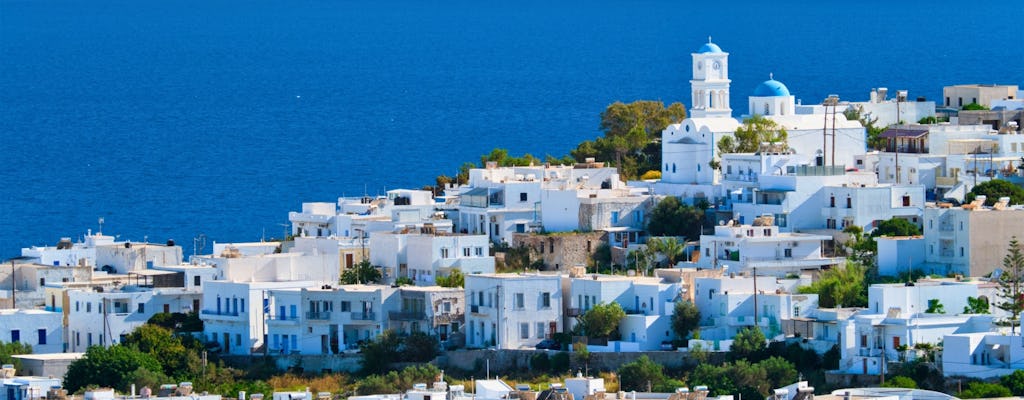This trip to Milos Island really covers all the bases. Your first stop is at one of the island's top stretches of sand, Sarakiniko Beach, where you can explore sea caves and go for a dip in the sea. From here, you'll visit the Aggeria Mines, where bentonite and perlite used to be dug up. Next up is the fishing village of Pollonia, where you can go for a seaside stroll and sample fresh seafood if you fancy it. You'll round off your visit to Milos Island with visits to Plaka, the capital, and Adamas, the island's main port.

Ferry tour of Milos Island – ticket only
- You can throw on your bathing suit and go for a swim at Sarakiniko Beach
- You'll head into the Aggeria Mines to hear how bentonite and perlite where dug up here years ago
- The tour includes time to explore the island's capital, Plaka, and the main port of Adamas
Boat cruise
Admission fees
Escort
Ferry ticket
- You must be at the departure point 40 minutes prior to 08.00 am departure
- Guided tour is available in the following languages:
English, French, German, Polish - Bring your passport or official EU identification
- Bring money for extras or gratuities
- Drinks not included
- Food and drinks not included
- Not suitable for guests who suffer from travel sickness
- Not suitable for guests with reduced mobility
- Bring a hat
- Subject to weather conditions
- Bring bathing gear and sunblock
- Bring a towel
What people say about this experience
At the moment there are no reviews for this experience.
You might also like

Nat Geo Day Tour: The Millenary History of Olive Oil
Approximate itinerary and duration of activitiesIntroduction - 15 minutesWalking tour through the olive trees - 30 minutesPause for questions and raki drink - 15 minutesOlive oil factory tour - 40 minutesOlive oil tasting and questions - 55 minutesCooking demonstration and tastings - 30 minutesPlease note the order of activities may vary at your guide's discretion With millennia of experience behind them, it's no wonder the people of Crete produce some of the finest olive oil in the world. You will appreciate the timeless bond between Cretans and their revered olive trees as you trace the long heritage of olive cultivation on the island. Just outside Kritsa village in the hills of eastern Crete, you'll follow Nikos Plevritakis on a brief walk to his olive groves where some trees are 600-800 years old, and learn about olive cultivation from a true specialist. In the shade of the olive trees, you can try local raki known as ‘tsikoudia' with olives to nibble on while discussing the cultural and societal significance of olive cultivation in Crete. Then it's time to visit a local cooperative factory, to see up close how olives are processed into world-class olive oil. Back on the Olive Path, seize the chance to taste fresh figs, almonds, and grapes, see what the locals are growing, and find out all about the Cretan lifestyle and diet. Then, at an olive farm, you can sample olives, fresh tomatoes, and raki before your olive oil tasting session begins – a great opportunity to learn how to taste oils like a professional and compare the flavor profiles of different varieties. Finish off the day with a cooking lesson on various ways to use olive oil in Cretan cuisine. Authentic dishes, such as tzatziki and Greek salad will feature, and you'll find out why the traditional Cretan diet is so beneficial to health and longevity.
de, en

Nat Geo Day Tour: Discover Cretan Farm Life
Small-scale, family-run farms are integral to the Mediterranean diet that Crete is so famous for. A local family will welcome you to their Mitato, a small farmhouse, where you'll be greeted with the genuine warmth of Cretan hospitality. Listen to the local farmer tell the intriguing tale of King Minoas who watched from his observatory, and alerted locals to incoming pirates. Greetings over, it's time for a hands-on bread-making lesson, learning the techniques for typical Cretan bread, made with wheat and barley flour. Then, witness their cheese-making skills using goat's milk from the farm. Next, it's time to roll up your sleeves and get stuck in, helping out with daily farm tasks like feeding the goats, pigs, chickens, and rabbits, and tending to the gardens. The adventure continues with a snail hunt over the mountainside, exclusive to National Geographic travellers, peeking under rocks, and among shrubs and flowers. As the day unfolds, your collected treasures, including snails, eggs, fruit, and vegetables, become the ingredients for lunch. Alongside the family, you'll prepare a feast of local delicacies, all made from the products of your day's work. Finish off the experience with a taste of Crete's spirit, Raki, and why not sing along to their traditional Cretan ‘Mantinades,' - traditional Cretan couplets that express sentiments about Cretan daily life.
de, en